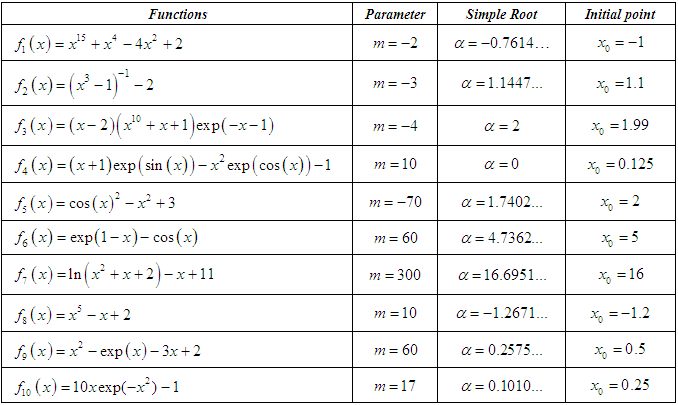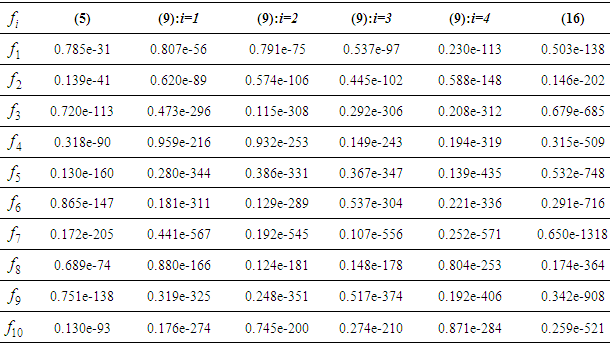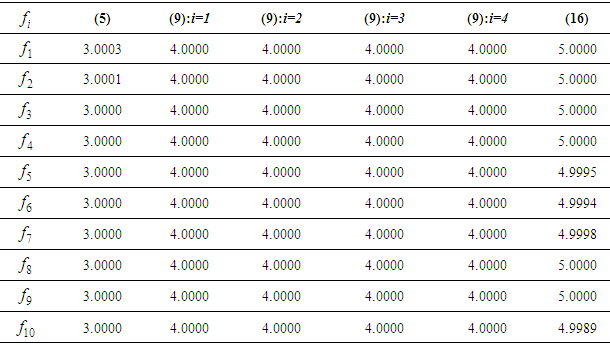R. Thukral
Padé Research Centre, 39 Deanswood Hill, Leeds, West Yorkshire, LS17 5JS, England
Correspondence to: R. Thukral, Padé Research Centre, 39 Deanswood Hill, Leeds, West Yorkshire, LS17 5JS, England.
| Email: |  |
Copyright © 2018 The Author(s). Published by Scientific & Academic Publishing.
This work is licensed under the Creative Commons Attribution International License (CC BY).
http://creativecommons.org/licenses/by/4.0/

Abstract
The objective of this paper is to present further development of the Simpson-type methods for finding zeros of a nonlinear equation. The new Simpson-type method is shown to converge of the order five. Per iteration the new method requires the same amount of evaluations of the function and therefore the new method has an efficiency index better than the other similar Simpson-type methods. We examine the effectiveness of the new fifth-order Simpson-type method by approximating the simple root of a given nonlinear equation. Numerical comparisons are made to show the performance of the new iterative method and thus verifies the theoretical results.
Keywords:
Simpson method, Newton method, Simple root, Nonlinear equation, Root-finding, Order of convergence
Cite this paper: R. Thukral, New Fifth-order Simpson-type Method for Solving Nonlinear Equations, American Journal of Computational and Applied Mathematics , Vol. 8 No. 4, 2018, pp. 80-84. doi: 10.5923/j.ajcam.20180804.03.
1. Introduction
In this paper, we present a new fifth-order iterative method to find a simple root of the nonlinear equation. It is well known that the techniques to solve nonlinear equations have many applications in science and engineering. We shall utilise two well-known techniques, namely the classical Newton method and the classical Simpson method, for their simplicity with convergence order of two and three respectively [1-13]. The new Simpson-type method requires the same amount of evaluations of the function as the classical Simpson method. Hence, we shall prove that the new Simpson-type iterative method has a better efficiency index than the other similar Simpson-type methods [1, 2, 4-7, 10, 12]. The prime motive for the development of the new fifth-order Simpson-type method was to increase the order of convergence of the recently introduced fourth-order Simpson-type methods.
2. The Method and Convergence Analysis
Let  be a real function with a simple root
be a real function with a simple root  and let
and let  be a sequence of real numbers that converge towards
be a sequence of real numbers that converge towards  The order of convergence p is given by
The order of convergence p is given by | (1) |
where  and
and  is the asymptotic error constant. Also, let
is the asymptotic error constant. Also, let  be the error in the kth iteration. Then the relation
be the error in the kth iteration. Then the relation | (2) |
is the error equation. If the error equation exists, then p is the order of convergence of the iterative method [3, 8, 9, 13].Furthermore, the efficiency of the method is measured by the concept of efficiency index, given by | (3) |
where r is the number of function evaluations of the method and p is the order of the convergence of the method [8]. In order to approximate the order of convergence of the method we use the following formula. Suppose that  and
and  are three successive iterations closer to the root
are three successive iterations closer to the root  of (1). Then the computational order of convergence may be approximated by
of (1). Then the computational order of convergence may be approximated by  | (4) |
where  [11]. Before we define the new fifth-order Simpson-type method we state essentially the classical third-order Simpson method and the recently introduced fourth-order Simpson-type method.
[11]. Before we define the new fifth-order Simpson-type method we state essentially the classical third-order Simpson method and the recently introduced fourth-order Simpson-type method.
2.1. The Classical Simpson Third-order Method
Since this method is well established, we shall state the essential expressions used in order to calculate the root of the given nonlinear equation. Hence the Simpson third-order method is given as | (5) |
where | (6) |
 | (7) |
 | (8) |
 is the initial approximation and provided that the denominator of (5) is not equal to zero.
is the initial approximation and provided that the denominator of (5) is not equal to zero.
2.2. The Simpson-type Fourth-order Methods
In this section we state the recently introduced fourth-order Simpson-type method to find simple root of a nonlinear equation. The improvement of the classical Simpson method was made by introducing a new factors in (5). Hence, the improved fourth-order Simpson-type methods is given by | (9) |
where 
 | (10) |
 | (11) |
 | (12) |
 | (13) |
 | (14) |
 | (15) |
Further details of the above methods are given in [12].
2.3. New Simpson-type Fifth-order Method
Here we present a new scheme to find simple root of a nonlinear equation. In order to increase the order of convergence of the classical Simpson method and the fourth-order Simpson-type method, we shall introduce a new different type of factor in (5). Hence, the scheme of the new fifth-order Simpson method is given by | (16) |
alternatively the new formula maybe expressed as | (17) |
where  is given by (6) and
is given by (6) and  | (18) |
Theorem 1Let  be a simple zero of a sufficiently differentiable function
be a simple zero of a sufficiently differentiable function  for an open interval D. If the initial guess
for an open interval D. If the initial guess  is sufficiently close to
is sufficiently close to  then the order of convergence of the new Simpson-type method defined by (16) is five.Proof Let
then the order of convergence of the new Simpson-type method defined by (16) is five.Proof Let  be a simple root of
be a simple root of  , i.e.
, i.e.  and
and  and the error is expressed as
and the error is expressed as  | (19) |
Using Taylor expansion, we have | (20) |
Taking  and simplifying, expression (20) becomes
and simplifying, expression (20) becomes | (21) |
where | (22) |
Furthermore, we have | (23) |
Dividing (21) by (23), we get | (24) |
and hence, we have | (25) |
The expansion of  about
about  is given as
is given as | (26) |
Since from (8) we have | (27) |
Taylor expansion of  about
about  is
is  | (28) |
The denominator of (5) is given as | (29) |
Dividing the numerator by denominator of (5), we get | (30) |
It is well established that the error equation of (5) is | (31) |
The improvement factors introduce in (16) are  | (32) |
 | (33) |
 | (34) |
Substituting appropriate expressions in (16), we obtain | (35) |
The error equation (35) establishes the fifth-order convergence of the new iterative method defined by (16).
3. Numerical Test Examples
The new fifth-order Simpson-type method given by (16) is employed to solve nonlinear equations with simple root. To demonstrate the performance of the new iterative method, ten particular nonlinear equations are used. The estimates are given of the approximate solutions produced by the methods considered and list the errors obtained by each of the methods. To determine the efficiency index of the new method, formula (3) will be used. Hence, the efficiency index of the new iterative method given by (16) is  whereas the efficiency index of the fourth-order Simpson-type method given by (9) is
whereas the efficiency index of the fourth-order Simpson-type method given by (9) is  and the efficiency index of the classical Simpson third-order method is given by (5) is
and the efficiency index of the classical Simpson third-order method is given by (5) is  Ten particular test functions are displayed in Table 1. The difference between the simple root and the approximation
Ten particular test functions are displayed in Table 1. The difference between the simple root and the approximation  for test functions with initial guess
for test functions with initial guess  are displayed in Table 2. In fact,
are displayed in Table 2. In fact,  is calculated by using the same total number of function evaluations for all methods. Furthermore, we display the computational order of convergence approximations in Table 3. From the tables we observe that the computational order of convergence perfectly coincides with the theoretical result.
is calculated by using the same total number of function evaluations for all methods. Furthermore, we display the computational order of convergence approximations in Table 3. From the tables we observe that the computational order of convergence perfectly coincides with the theoretical result.Table 1. Test functions and their simple roots
 |
| |
|
Table 2. Errors occurring in the estimates of the simple root by the methods described
 |
| |
|
Table 3. Performance of computational order of convergence
 |
| |
|
4. Conclusions
In this paper, we have demonstrated the performance of the new iterative method, namely the Simpson-type fifth-order iterative method. The prime motive of the development of the new fifth-order method was to establish a higher order of convergence method than the classical Simpson third-order iterative method and recently introduced the Simpson-type fourth-order iterative methods. It is shown that the efficiency index of the new fifth-order method is much better than the fourth-order Simpson-type method and the classical Simpson third-order method. Numerical comparisons are made to demonstrate the performance of the derived method. We have examined the effectiveness of the new fifth-order iterative method by showing the accuracy of the simple root of a nonlinear equation.
References
| [1] | N. Ahmad, V. P. Singh, A New Iterative Method for Solving Nonlinear Equations Using Simpson Method, Inter. J. Math. Appl. 5 (4) (2017) 189–193. |
| [2] | Eskandari, H. Simpson’s Method for Solution of Nonlinear Equation. Appl. Math. 8 (2017) 929-933. |
| [3] | W. Gautschi, Numerical Analysis: an Introduction, Birkhauser, 1997. |
| [4] | V. I. Hasanov, I. G. Ivanov, G. Nedjibov, A New modification of Newton’s method, Appl. Math. Eng (2015) 278-286. |
| [5] | J. Jayakumar, Generalized Simpson-Newton's Method for Solving Nonlinear Equations with Cubic Convergence, J. Math. 7 (5) (2013) 58-61. |
| [6] | G. Nedjibov, V. I. Hasanov, M. G. Petkov, On some families of multi-point iterative methods for solving nonlinear equations, Numer. Algo. 42 (2) (2006) 127-136. |
| [7] | A. M. Ostrowski, Solutions of equations and system of equations, Academic Press, New York, 1960. |
| [8] | S. Nazneem, A new approach of Newton’s method using Simpson’s rule, Asian J. Appl. Sci. Tech. 2 (1) (2018) 135-138. |
| [9] | M. S. Petkovic, B. Neta, L. D. Petkovic, J. Dzunic, Multipoint methods for solving nonlinear equations, Elsevier 2012. |
| [10] | U. K. Qureshi, A new accelerated third-order two-step iterative method for solving nonlinear equations, Math. Theory Model. 8 (5) (2018) 64-68. |
| [11] | R. Thukral, New modifications of Newton-type methods with eighth-order convergence for solving nonlinear equations, J. Adv. Math. Vol 10 (3) (2015) 3362-3373. |
| [12] | R. Thukral, Further acceleration of the Simpson method for solving nonlinear equations, J. Adv. Math. Vol 14 (2) (2018) 7631-7639. |
| [13] | J. F. Traub, Iterative Methods for solution of equations, Chelsea publishing company, New York 1977. |



 be a real function with a simple root
be a real function with a simple root  and let
and let  be a sequence of real numbers that converge towards
be a sequence of real numbers that converge towards  The order of convergence p is given by
The order of convergence p is given by
 and
and  is the asymptotic error constant. Also, let
is the asymptotic error constant. Also, let  be the error in the kth iteration. Then the relation
be the error in the kth iteration. Then the relation

 and
and  are three successive iterations closer to the root
are three successive iterations closer to the root  of (1). Then the computational order of convergence may be approximated by
of (1). Then the computational order of convergence may be approximated by 
 [11]. Before we define the new fifth-order Simpson-type method we state essentially the classical third-order Simpson method and the recently introduced fourth-order Simpson-type method.
[11]. Before we define the new fifth-order Simpson-type method we state essentially the classical third-order Simpson method and the recently introduced fourth-order Simpson-type method. 



 is the initial approximation and provided that the denominator of (5) is not equal to zero.
is the initial approximation and provided that the denominator of (5) is not equal to zero. 









 is given by (6) and
is given by (6) and 
 be a simple zero of a sufficiently differentiable function
be a simple zero of a sufficiently differentiable function  for an open interval D. If the initial guess
for an open interval D. If the initial guess  is sufficiently close to
is sufficiently close to  then the order of convergence of the new Simpson-type method defined by (16) is five.Proof Let
then the order of convergence of the new Simpson-type method defined by (16) is five.Proof Let  be a simple root of
be a simple root of  , i.e.
, i.e.  and
and  and the error is expressed as
and the error is expressed as 

 and simplifying, expression (20) becomes
and simplifying, expression (20) becomes




 about
about  is given as
is given as

 about
about  is
is 







 whereas the efficiency index of the fourth-order Simpson-type method given by (9) is
whereas the efficiency index of the fourth-order Simpson-type method given by (9) is  and the efficiency index of the classical Simpson third-order method is given by (5) is
and the efficiency index of the classical Simpson third-order method is given by (5) is  Ten particular test functions are displayed in Table 1. The difference between the simple root and the approximation
Ten particular test functions are displayed in Table 1. The difference between the simple root and the approximation  for test functions with initial guess
for test functions with initial guess  are displayed in Table 2. In fact,
are displayed in Table 2. In fact,  is calculated by using the same total number of function evaluations for all methods. Furthermore, we display the computational order of convergence approximations in Table 3. From the tables we observe that the computational order of convergence perfectly coincides with the theoretical result.
is calculated by using the same total number of function evaluations for all methods. Furthermore, we display the computational order of convergence approximations in Table 3. From the tables we observe that the computational order of convergence perfectly coincides with the theoretical result. Abstract
Abstract Reference
Reference Full-Text PDF
Full-Text PDF Full-text HTML
Full-text HTML

